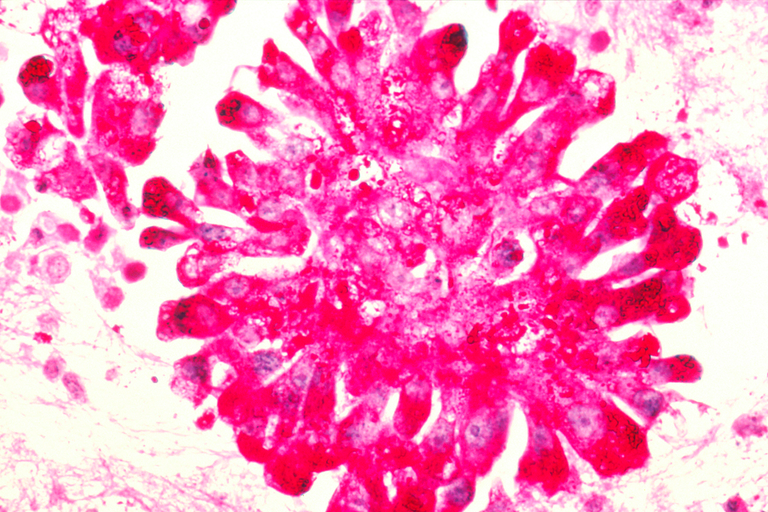Mutations to Rous's Protooncogenes and Sarcoma of Rous
The first class of genes we analyze are oncogenes, which are nothing more than the product of a mutation involving a protooncogen.
The discovery of the existence of oncogenes is relatively recent: it dates back to the 1980s. That of oncosuppressants is even more recent.
Oncogenes were discovered thanks to an experiment conducted on a chicken in the United States that developed a breast sarcoma and was brought to the farmer by a researcher, Dr. Rous. These were years in which the concept of viruses was depopulated: the biology of viruses had absolutely exploded and people were beginning to think that tumors could also be caused by them.
On the wave of this, Dr. Rous took this chicken tumor, homogenized it and filtered it through a filter with pores so tight that only viruses present in the cells removed from the chicken could pass through. He took this filtered with any virus from the tumor and inoculated it into another healthy chicken. This chicken developed the same type of tumor. It was the beginning of the identification of the Rous sarcoma virus (RSV), which was named after the researcher who demonstrated its ability to induce cancer.
It is an avian retrovirus to RNA, oncogenic, i.e. able to generate cancer only in birds.
It has been observed that if infected with this virus some chicken fibroblasts transform and become cells insensitive to contact inhibition and continue to proliferate like cancer cells.
Therefore, this virus alone is able to give the cell characteristics of the tumor cell and is able to induce tumor in the animal when inoculated.

Distinctive feature of oncogenic viruses
What is so special about RSV compared to all other non-oncogenic RNA viruses?
All RNA retroviruses have the LTR sequence and the three classic
genes, GAG, POL and ENV, which allow the replication of the viral genome when it infected the cell.
When an RNA virus enters the cell, its genome is
copied into DNA, and may or may not be integrated into the cellular genome. From this DNA, new RNA molecules are generated that give rise to new virions, then new viral particles that will then infect other cells through a lysogenic cycle.
The difference between a non-oncogenic virus and an oncogenic virus such as RSV is that it has an
extra gene: the SRC gene (sarcoma gene).
It has been shown that the ability of the virus to induce cancer is closely linked to the presence of this new genetic information.
It was discovered that this gene is nothing more than a cellular gene, which had been captured by a virus that had infected the cell. When this cell started to produce the new virions, it had accidentally inserted its own genetic information into their genome. This gene sequence is called c-src (cell gene).
This cellular gene, once integrated into the viral genome, has been subjected to numerous mutations during the various replication processes in the history of the virus (the viral genome is highly susceptible to mutations), giving rise to what is called the v-src, where "v" stands for virus.

It is the equivalent of the cellular gene, but it has become viral and mutated in an activatory sense.
Therefore, when this type of virus infects the cell, besides inserting its own RNA into the cell, it also inserts this information, originating from the same cell but strongly mutated inside the virus.
This gene is also strongly expressed in the infected cell, because its expression is under the control of the LTR sequence of the virus, which guides the expression of viral DNA. In this way the v-src sequence is amplified and produced in a very high number of copies during the production of many new virions.
This means that the cell infected by this virus will express a gene that was a very highly mutated cell gene.
This event, which occurs simultaneously in all the cells that have been infected with the virus, is the unique case that allows a single gene mutation to generate cancer.
When an oncogenic RNA virus infects a cell population and carries out this type of gene alteration within the entire cell population, mutual control between cell and cell is lost and cell proliferation is suppressed.
These cells, all altered at the same time, give rise to cancer, which in this case will not be monoclonal but polyclonal.
The v-sarc gene discovered in this virus has stimulated the suspicion that in non-virus-induced tumors the same gene could be mutated in a similar way.
The first results were surprising: it was discovered that c-sarc is nothing more than a protooncogene that is completely mutated in the virus to give v-sarc.
In fact, the same gene was found in a mutated form, without the intervention of the virus, in different types of tumors.
In this way the existence of protooncogenes has been discovered.
It was later discovered that there are many viruses capable of inducing tumours in various species.
The feline leukaemia virus is one example and cats are vaccinated against it. This carries a v-onc (viral oncogene) in its RNA which is nothing more than a mutated copy of a cellular protooncogene.
Pictures
Sources
Mutazioni ai Protooncogeni e Sarcoma di Rous
La prima classe di geni che analizziamo sono gli oncogeni, che non sono altro che il prodotto di una mutazione che ha riguardato un protooncogene.
La scoperta dell’esistenza degli oncogeni è relativamente recente: risale agli anni 80. Quella degli oncosoppressori è ancora più recente.
Gli oncogeni sono stati scoperti grazie ad un esperimento condotto su un pollo che negli Stati Uniti sviluppò un sarcoma mammario e venne portato dall’allevatore da un ricercatore, il dottor Rous. Erano anni in cui spopolava il concetto di virus: la biologia dei virus era assolutamente esplosa e si iniziava a pensare che anche i tumori potessero essere causati dai essi.
Sull’onda di questo il dottor Rous prese questo tumore di pollo, lo omogeneizzò e lo filtrò attraverso un filtro a pori tanto stretti da consentire il passaggio esclusivamente a eventuali virus presenti nelle cellule sottratte al pollo. Prese questo filtrato con gli eventuali virus del tumore e lo inoculò in un altro pollo,sano. Questo pollo sviluppò lo stesso tipo di tumore. Fu l’inizio dell’identificazione del virus del sarcoma di Rous (RSV), che prese il nome proprio dal ricercatore che ha dimostrato la sua capacità di indurre cancro.
È un retrovirus aviario a RNA, oncogeno, cioè in grado di generare cancro solo negli uccelli.
Si è osservato che se si infettano con questo virus alcuni fibroblasti di pollo questi si trasformano e diventano cellule insensibili all’inibizione da contatto e continuano a proliferare come le cellule tumorali.
Quindi questo virus, da solo, è in grado di conferire alla cellula delle caratteristiche proprie della cellula tumorale ed è in grado di indurre tumore nell’animale quando inoculato.

Caratteristica peculiare dei virus oncogeni
Cos’ha il RSV di particolare rispetto a tutti gli altri virus a RNA non oncogeni?
Tutti i retrovirus a RNA presentano la sequenza LTR e i tre classici
geni, GAG, POL e ENV, i quali consentono la replicazione del genoma virale nel momento in cui questo ha infettato la cellula.
Quando un virus a RNA entra nella cellula, il suo genoma viene
copiato in DNA, ed eventualmente può essere integrato nel genoma cellulare o meno. Da questo DNA si generano nuove molecole di RNA che danno origine a nuovi virioni, quindi nuove particelle virali che poi andranno a infettare altre cellule attraverso un ciclo lisogeno.
La differenza tra un virus non oncogeno e un virus oncogeno come il RSV è che questo presenta un
gene in più: il gene SRC (gene del sarcoma).
Fu dimostrato che la capacità del virus di indurre cancro è strettamente legata alla presenza di questa nuova informazione genetica.
Si scoprì che questo gene non è altro che un gene cellulare, che era stato catturato da un virus che aveva infettato la cellula. Nel momento in cui questa cellula aveva iniziato a produrre i nuovi virioni aveva inserito per sbaglio nel genoma di questi anche una sua propria informazione genica. Questa sequenza genica viene detta c-src (gene cellulare).
Questo gene cellulare, una volta integrato nel genoma virale, è andato incontro, durante i vari processi di replicazione nella storia del virus, a numerose mutazioni (il genoma virale è fortemente suscettibile a mutazioni), dando origine a quello che viene definito il v-src, dove “v” sta per virus.

Si tratta dell’equivalente del gene cellulare, che però è diventato virale ed è mutato in senso attivatorio.
Quindi, quando questo tipo di virus infetta la cellula, oltre che inserire il proprio RNA nella cellula, inserisce anche questa informazione, originata dalla stessa cellula ma fortemente mutata all’interno del virus.
Questo gene è anche fortemente espresso nella cellula infettata, perché la sua espressione è sotto il controllo della sequenza LTR del virus, che guidano l’espressione del DNA virale. In questo modo la sequenza v-src viene amplificata e prodotta in un elevatissimo numero di copie durante la produzione di moltissimi nuovi virioni.
Ciò significa che la cellula infettata da questo virus esprimerà un gene che era un gene cellulare mutato in maniera elevatissima.
Questo evento, che avviene contemporaneamente in tutte le cellule che sono state infettate del virus, è il caso unico che consente ad un’unica mutazione genica di generare tumore.
Quando un virus a RNA oncogeno infetta una popolazione cellulare ed effettua questo tipo di alterazione genica all’interno di tutta la popolazione cellulare, si perde il controllo reciproco tra cellula e cellula e viene a mancare la soppressione della proliferazione cellulare.
Queste cellule tutte alterate contemporaneamente danno origine a tumore, che in questo caso non sarà monoclonale ma policlonale.
Il gene v-sarc scoperto in questo virus ha stimolato il sospetto che nei tumori non indotti da virus lo stesso gene potesse essere mutato in maniera simile.
I primi risultati furono sorprendenti: si scoprì che il c-sarc non è altro che un protooncogene che nel virus viene completamente mutato a dare v-sarc.
Si è ritrovato infatti lo stesso gene in forma mutata, senza l’intervento del virus, in diversi tipi di tumore.
In questo modo si è scoperta l’esistenza dei protooncogeni.
Si è poi scoperto in seguito che sono molti i virus in grado di indurre tumori in varie specie.
Il virus della leucemia felina ne è un esempio e i gatti vengono vaccinati contro di esso. Questo porta nel suo RNA un v-onc (oncogene virale) che non è altro che la copia mutata di un protooncogene cellulare.
Immagini
Fonti
it was little bit scientifical, with the help google finally understood it.
Cool man it was like a simple and clear explanation of a complicated Oncovirus.
!discovery 35
This post was shared and voted inside the discord by the curators team of discovery-it
Join our community! hive-193212
Discovery-it is also a Witness, vote for us here
Thanks for your contribution to the STEMsocial community. Feel free to join us on discord to get to know the rest of us!
Please consider supporting our funding proposal, approving our witness (@stem.witness) or delegating to the @steemstem account (for some ROI).
Please consider using the STEMsocial app app and including @stemsocial as a beneficiary to get a stronger support.